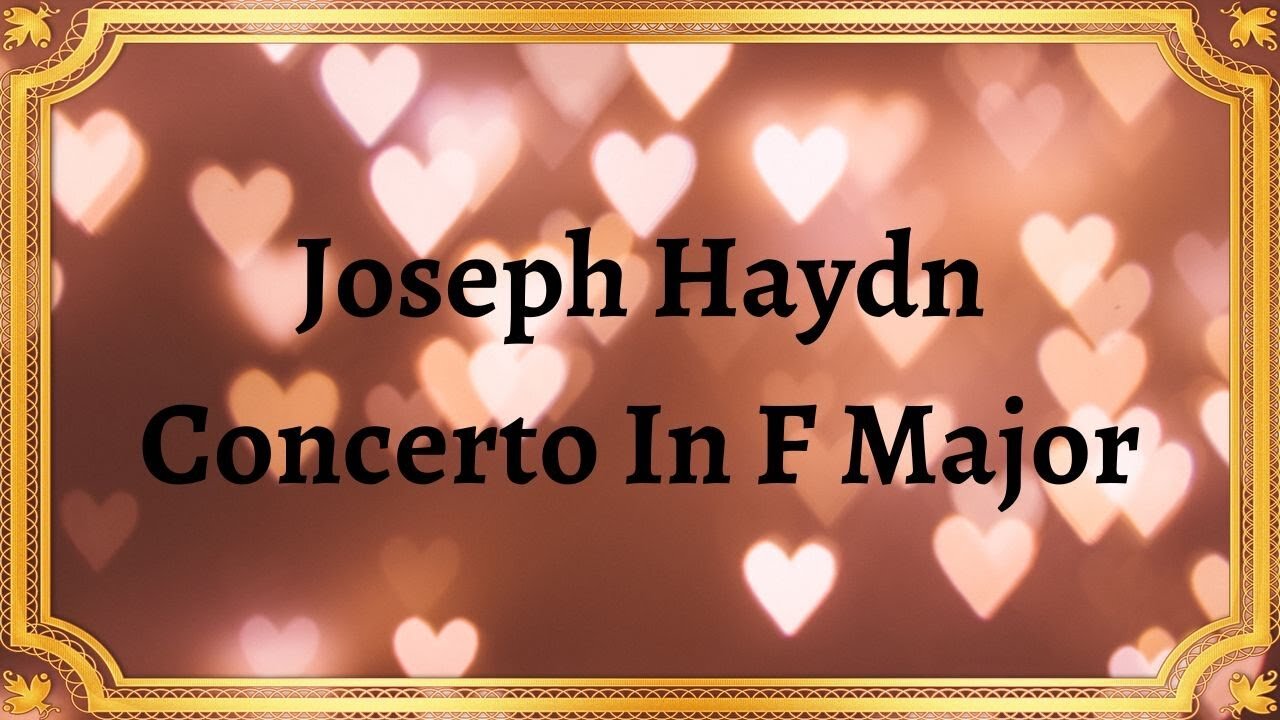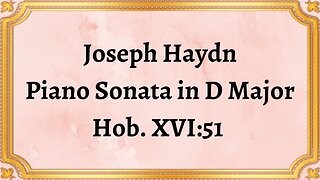Premium Only Content

Joseph Haydn Concerto In F Major
#JosephHaydn #Concerto #FMajor #ClassicalMusic #MusicalComposition
#Haydn #InstrumentalMusic #OrchestralMusic #ClassicalEra #AustrianComposer
Publication date 1951
THE LONDON BAROQUE ENSEMBLE Karl Nags Conductor
Classical music has bestowed upon us a treasure trove of timeless masterpieces, and among them shines brightly the "Joseph Haydn Concerto In F Major."
The "Joseph Haydn Concerto In F Major" was composed by the renowned Austrian composer Joseph Haydn during the late 18th century. Haydn, often referred to as the "Father of the Symphony," was a prolific composer whose contributions to classical music are immeasurable. This concerto represents a pinnacle of his compositional prowess and serves as a testament to his enduring legacy.
The concerto is a genre that showcases the virtuosity of a solo instrument, accompanied by an orchestra. In the case of the "Joseph Haydn Concerto In F Major," it follows a typical three-movement structure: Allegro moderato, Adagio, and Tempo di Minuetto.
The first movement, Allegro moderato, bursts forth with an exuberant energy. It introduces the main themes and motifs that will be developed and explored throughout the concerto. The solo instrument takes center stage, engaging in a delightful dialogue with the orchestra. Haydn's meticulous craftsmanship shines through the interplay between the soloist and the ensemble, creating a sense of musical conversation.
The second movement, Adagio, transports the listener to a realm of sublime beauty and emotional depth. It is characterized by its lyrical melodies and tender expressions. The solo instrument sings with a heartfelt melancholy, often accompanied by lush orchestral harmonies. Haydn's ability to evoke profound emotions through his music is showcased in this movement, leaving a lasting impression on the audience.
The final movement, Tempo di Minuetto, concludes the concerto with a spirited and lively character. It is marked by its dance-like rhythm and playful melodies. The soloist and orchestra engage in a joyful dialogue, captivating the listener with their intricate interplay. The movement builds up to an exhilarating finale, leaving the audience in awe of Haydn's compositional brilliance.
The "Joseph Haydn Concerto In F Major" possesses several captivating elements that make it truly remarkable. Haydn's gift for crafting memorable melodies and his ability to balance the solo instrument and orchestral accompaniment showcases his mastery of composition. The concerto exudes a sense of elegance, wit, and charm, which are characteristic of Haydn's style. The use of dynamics, phrasing, and ornamentation further enhances the musical narrative, allowing the audience to be fully immersed in the enchanting world of the concerto.
The "Joseph Haydn Concerto In F Major" stands as a testament to the genius of Joseph Haydn and the enduring beauty of classical music. Its historical significance, well-structured form, and captivating elements make it a beloved and cherished composition among musicians and audiences alike. This concerto serves as a testament to Haydn's immense contributions to the classical era, leaving a lasting legacy that continues to inspire and captivate listeners to this day.
You have the opportunity to support the channel https://destream.net/live/RadSiarAl/donate
-
 6:07
6:07
Classical music_Music Inspiration
6 days agoJoseph Haydn Piano Sonata in D Major, Hob. XVI:51
341 -
 2:41:03
2:41:03
I_Came_With_Fire_Podcast
12 hours ago🔥🔥Suing CHINA, Hillary AIDED RUSSIA, and DEI REMOVED from Military🔥🔥
64.2K10 -
 LIVE
LIVE
SoniCentric
13 hours agoCozy Up With SNOWY Lakeside Cabin Jazz Vibes
154 watching -
 1:36:16
1:36:16
PMG
1 day ago $0.69 earnedSPECIAL: JUSTICE FOR JEREMY - NOW!
26.8K4 -
 1:01:01
1:01:01
TheTapeLibrary
15 hours ago $3.05 earnedThe Horrifying True Story of Summerwind Mansion
37.9K7 -
 29:28
29:28
Afshin Rattansi's Going Underground
1 day agoMax Blumenthal on US’ Ukraine Aid Corruption, 'Psychotic' Israel Turning the West Bank into Gaza
42.3K4 -
 57:12
57:12
Flyover Conservatives
1 day agoCovid, Control, & Corruption —Dr. Stella Immanuel’s Plan to BEAT the System! | FOC Show
29.8K -
 57:13
57:13
Sarah Westall
8 hours agoUnited States in a Two Front War, Identify Military Psyops and Special Operations w/ Jeffrey Prather
68.2K14 -
 2:14:05
2:14:05
Quite Frankly
12 hours ago"Open Phones: Philly & D.C. Crashes" 1/31/25
53.3K20 -
 1:45:32
1:45:32
2 MIKES LIVE
11 hours ago2 MIKES LIVE #173 Open Mike Friday!
52K1